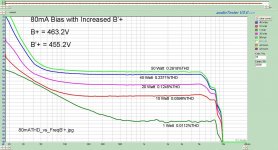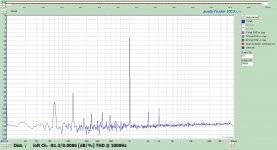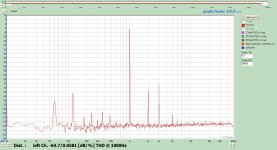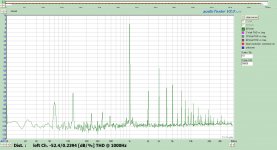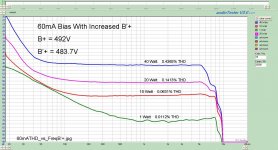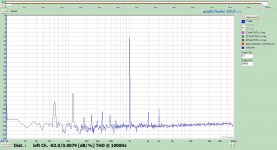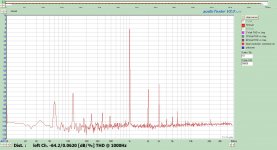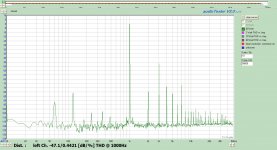Here is the supporting spectrum of the above plots. This one at 80mA KT88 bias. Spectrum are at 1kHz, 50Watt = 0dB. FFT are respectfully 1 Watt, 10 Watt, and 40 Watt.
Attachments
Here is the same measurements taken at 60mA bias. Same scale and power settings as above.
I keep the amp set at 70mA for general listening as it takes a load off of the PT and puts a little less stress on the tubes.
I keep the amp set at 70mA for general listening as it takes a load off of the PT and puts a little less stress on the tubes.
Attachments
WOW Awsome !
Hi Scott
Yes I know what you mean about the paper, just got 100 more plastic pages for my files the other day.
The amp looks great, you now have a 'virtual' folder in my PC gallery of inspiration (saves even more paper build up).
Makes me think my 5-10 style rebuild would be def under powered !
I always toyed with the idea of a 300b for years, but a bit of chunky bass is needed for my listening pleasure.
When I joined diyAudio I was considering building a pair of Nelson's SE BA-1's, the thread on that seems dead as a door-nail, and I don't know why. BA-1 seems like a fairly cheap and simple build, am wondering if people are scared of the shear number (24) of output devices and the cooling problem.
Nice thing about tubes is they solve their own cooling problems, not much aly in tube amps, just LOT'S OF IRON !
The design and tube choice is interesting, a friend of mine has just rebuilt a pair of Quad II's (KT88 or is it 66, can't remember without looking), and is most happy with the results.
In the case of the Quads well worth doing, decent output transformers I think.
I think the only sensible SE option if you want chunky bass is SS like Nelson's BA-1.
I am lead to believe in some older amps the tube rectifiers some times starve the bass of power, but with bigger decent modern capacitors maybe that isn't such a problem with a rebuid.
Certainly looks like your not short of a uF or two !
If I decide to go tube for the new amps, I suppose I should seriously consider a format like yours with decent power.
Have had the same amp since 1988 now and have been happy enough, but am a bit tired of it now and my whole system is now under the microscope !
I was interested in the Heathkit MA-12's as I have had them gathering dust for 20 years and not much point in hanging on to stuff (junk) you don't use. I was shocked to see some on the net (unrefurbished) going for $600.
Reckon I should get on with the TT refurb and sim NJFET build whilst I decide what to do about the amps,
Totaly love the wood grain pattern on the front of you monoblock, very nice.
Cheer Simon...

Been a while, but time for an update and some peer review.
Here are the photo's of the amp. Both inside and out.
Hi Scott
Yes I know what you mean about the paper, just got 100 more plastic pages for my files the other day.
The amp looks great, you now have a 'virtual' folder in my PC gallery of inspiration (saves even more paper build up).
Makes me think my 5-10 style rebuild would be def under powered !
I always toyed with the idea of a 300b for years, but a bit of chunky bass is needed for my listening pleasure.
When I joined diyAudio I was considering building a pair of Nelson's SE BA-1's, the thread on that seems dead as a door-nail, and I don't know why. BA-1 seems like a fairly cheap and simple build, am wondering if people are scared of the shear number (24) of output devices and the cooling problem.
Nice thing about tubes is they solve their own cooling problems, not much aly in tube amps, just LOT'S OF IRON !
The design and tube choice is interesting, a friend of mine has just rebuilt a pair of Quad II's (KT88 or is it 66, can't remember without looking), and is most happy with the results.
In the case of the Quads well worth doing, decent output transformers I think.
I think the only sensible SE option if you want chunky bass is SS like Nelson's BA-1.
I am lead to believe in some older amps the tube rectifiers some times starve the bass of power, but with bigger decent modern capacitors maybe that isn't such a problem with a rebuid.
Certainly looks like your not short of a uF or two !
If I decide to go tube for the new amps, I suppose I should seriously consider a format like yours with decent power.
Have had the same amp since 1988 now and have been happy enough, but am a bit tired of it now and my whole system is now under the microscope !
I was interested in the Heathkit MA-12's as I have had them gathering dust for 20 years and not much point in hanging on to stuff (junk) you don't use. I was shocked to see some on the net (unrefurbished) going for $600.
Reckon I should get on with the TT refurb and sim NJFET build whilst I decide what to do about the amps,
Totaly love the wood grain pattern on the front of you monoblock, very nice.
Cheer Simon...

Thanks Simon.
I would build these again. They have never become tiresome to listen too. In fact, my desire to bi-amp has almost dissappeared other than for curiosity. I have finally answered my preference about the caps. They stay in. You can feel the difference primarily in huge transients when watching Blue Rays. (Star Trek comes to mind). With the motor run bypass however, their "slowness" isn't apparent at all and un detectable.
My tweeks this winter are to goto a discrete CCS or possibly a gyrator for the input tubes and and discrete CCS for the fet followers. I would also like to increase the voltage swing of the LTP to obtain further headroom, but that will require more PT iron. That I have to budget for. There is a much simpler build going on slowly by Tubemack with a more conventional Mullard 5-20. I am very eager to see his results when he completes them. The OPUS was a variation/spin off of his thread.
Your plan is reasonable. Get good source together and build outward.
Pass Labs is good stuff as well. To be honest, I prefer the designs with fewer output devices, not because of heat but because of sound. I have on hand an Aleph 5, Aleph X-100Watt, and a Zen V4. My Aleph 3 went to a friend. The 5 was my favorite at the time since it was able to drive my old speakers. The 3 had more detail and sound stage but lost control in the LF area at higher volumes. The 3 would drive my new speakers very well, however.
The BA-1 looks interesting, but I have not been following too closely recently.
I need to get these back on the bench and get a new set of measurements now that I know a little more about testing. Would like to see how much of the harmonic grass I had was related to the measuremnt system.
I would build these again. They have never become tiresome to listen too. In fact, my desire to bi-amp has almost dissappeared other than for curiosity. I have finally answered my preference about the caps. They stay in. You can feel the difference primarily in huge transients when watching Blue Rays. (Star Trek comes to mind). With the motor run bypass however, their "slowness" isn't apparent at all and un detectable.
My tweeks this winter are to goto a discrete CCS or possibly a gyrator for the input tubes and and discrete CCS for the fet followers. I would also like to increase the voltage swing of the LTP to obtain further headroom, but that will require more PT iron. That I have to budget for. There is a much simpler build going on slowly by Tubemack with a more conventional Mullard 5-20. I am very eager to see his results when he completes them. The OPUS was a variation/spin off of his thread.
Your plan is reasonable. Get good source together and build outward.
Pass Labs is good stuff as well. To be honest, I prefer the designs with fewer output devices, not because of heat but because of sound. I have on hand an Aleph 5, Aleph X-100Watt, and a Zen V4. My Aleph 3 went to a friend. The 5 was my favorite at the time since it was able to drive my old speakers. The 3 had more detail and sound stage but lost control in the LF area at higher volumes. The 3 would drive my new speakers very well, however.
The BA-1 looks interesting, but I have not been following too closely recently.
I need to get these back on the bench and get a new set of measurements now that I know a little more about testing. Would like to see how much of the harmonic grass I had was related to the measuremnt system.
Both are good. I actually prefer the UL tube amp. It has a more realistic presentation IMHO.
boywonder, I will report back in a few. Need to review the last schema I posted before I comment. I can't remember if I updated with the current bias adjustment impedance.
P.S. The last schematic posted is not the version I am currently running. I am still running the 5687 input tube, however, I see that the input impedance is off, the RC bypass is still shown and the impedance of the bias is off. Also not shown is that I installed a little booster trany in the C- supply to give me -150V. When I order new PT's, I am going to correct that to simplify the power plate. I further installed an 0D3 on the input tube. I should mention that I want to try a Salas Super Simple HV reg there. Give me a few days and I will post an updated schema with recommended changes and values.
P.S.S. I went ferrite bead crazy when trying to eliminate the oscillation I had. I only have a few left installed. I will update that as well.
boywonder, I will report back in a few. Need to review the last schema I posted before I comment. I can't remember if I updated with the current bias adjustment impedance.
P.S. The last schematic posted is not the version I am currently running. I am still running the 5687 input tube, however, I see that the input impedance is off, the RC bypass is still shown and the impedance of the bias is off. Also not shown is that I installed a little booster trany in the C- supply to give me -150V. When I order new PT's, I am going to correct that to simplify the power plate. I further installed an 0D3 on the input tube. I should mention that I want to try a Salas Super Simple HV reg there. Give me a few days and I will post an updated schema with recommended changes and values.
P.S.S. I went ferrite bead crazy when trying to eliminate the oscillation I had. I only have a few left installed. I will update that as well.
Last edited:
As built Schematic
Here is how it is built now. Exception being the 0D3 and the input tube. I would leave it with the 12bh7 as originally designed.
I looked and saw that I had the latest revision documented just never posted.
The power supply v10 is a good starter except for the increased C- rail. Not many people have access to the inverter caps and they aren't required to make this amp work. I would run it close to 500V as it gives the LTP a little more room to operate. I have thought to tie the ltp to a negative rail as well but don't have room in the chassis.
Here is how it is built now. Exception being the 0D3 and the input tube. I would leave it with the 12bh7 as originally designed.
I looked and saw that I had the latest revision documented just never posted.
The power supply v10 is a good starter except for the increased C- rail. Not many people have access to the inverter caps and they aren't required to make this amp work. I would run it close to 500V as it gives the LTP a little more room to operate. I have thought to tie the ltp to a negative rail as well but don't have room in the chassis.
Attachments
Thanks Simon.
Pass Labs is good stuff as well. To be honest, I prefer the designs with fewer output devices, not because of heat but because of sound. I have on hand an Aleph 5, Aleph X-100Watt, and a Zen V4.
Hi again Scott
Thanks for the input on the Pass Labs stuff, you've obviously gone with quite a few of those.
What did you think of your Zen v4 ?
I know what you mean about less output devices, although I think I was led to believe from somewhere (don't know if this is true) that multi paralleled MOSFETS apart from spreading the heat dissipation, are also lower noise etc. as a result.
The BA-1 is so simple it's untrue. It appears you don't even need the front end if you have 0.5v to put in. The bias circiut is about half a dozen parts, and it seems you can crank it up as far as your PSU and cooling will allow.
The other thing on paper that looked interesting about the BA-1 was that all the graphs just showed dead straight lines, a totaly linear amplifier, it reminded me of RF power amps for radio comms.
Apart from the BA-1, the one that struck me as most interesting on paper (don't ask me why) was the 'Son Of Zen v7a', it's 'Xed' and has balanced same channel pair of MOSFETS, single supply rail and less power resistor burn off than the original 'Son Of Zen'.
The 'Balanced Zen Line Stage' also looked interesting to me, and I had wondered if 2 in series might make a good 2 gain control microphone preamp. Maybe the 2SK170 is best for mics as well, although the IRFP610's powered on 60v did seem to have exellent noise figs. etc.
Out of interest Scott, do you happen to use/have, or recommend, a lo(ish) gain valve line stage circuit, another area I need to look into.
Cheers Simon...
Simon, the Line stage is simple. The circuit is even simpler. The 12b4. I am currently in the process of doing a study on this. My first was a resistive load with bypassed CCS cathode. It was my first "tube" diy project and was sloppy p2p construction. (still worked well though). I am currently running a simple CCS load (10M45) at 17mA with LED bias. Tubes are still relativley inexpensive and can be obtained easily. You will need to get several pair however, as some tend to be very noisy. Select the good ones and be happy.
I have parts to look at a discrete CCS load, and a gyrator load. In addition will be looking at the Salas Super Simple HV shunt reg vs. the 0D3.
Regarding the Pass lab stuff, yes the noise goes down with more FETs but to me the detail was lost. Noise is the same reason you see in the higher gain Salas RIAA two jfets. PassLabs also did it in the Pearl V2, as well as many other designers. IMHO, it takes VERY careful FET matching to maintain the detail as you parallel more together.
The BOSOZ is a good balanced preamp. Made one of those too. The x100 required balanced input and I ran the aleph 5 in balanced mode. I still have it and will probably use it someday in a dedicated theater system. Don't ask me how the x100 sounded as I can't remember. I had to run seperate power feeds from the breaker panel to each amp in my old house. I live in NY now and electricity is way toooo expensive to even consider them. They dissapated >750Watts each.
Need to do some reading on the BA-1. I don't recall the performance specs. Simpler is better up to a point.
The Zen V4 still gets played every day and has been very reliable. Not bad sounding but seriously lacking in bass control. A GREAT amplifier for the kids!!!! It does not play rap well at all so it generates very little interest (for that type of music) for them.
I have parts to look at a discrete CCS load, and a gyrator load. In addition will be looking at the Salas Super Simple HV shunt reg vs. the 0D3.
Regarding the Pass lab stuff, yes the noise goes down with more FETs but to me the detail was lost. Noise is the same reason you see in the higher gain Salas RIAA two jfets. PassLabs also did it in the Pearl V2, as well as many other designers. IMHO, it takes VERY careful FET matching to maintain the detail as you parallel more together.
The BOSOZ is a good balanced preamp. Made one of those too. The x100 required balanced input and I ran the aleph 5 in balanced mode. I still have it and will probably use it someday in a dedicated theater system. Don't ask me how the x100 sounded as I can't remember. I had to run seperate power feeds from the breaker panel to each amp in my old house. I live in NY now and electricity is way toooo expensive to even consider them. They dissapated >750Watts each.
Need to do some reading on the BA-1. I don't recall the performance specs. Simpler is better up to a point.
The Zen V4 still gets played every day and has been very reliable. Not bad sounding but seriously lacking in bass control. A GREAT amplifier for the kids!!!! It does not play rap well at all so it generates very little interest (for that type of music) for them.
Last edited:
Simon, the Line stage is simple. The circuit is even simpler. The 12b4. In addition will be looking at the Salas Super Simple HV shunt reg vs. the 0D3.
Hi Scott
Maybe I could rent a X100 for the winter, it's getting a bit chilly here !
You've just increased my paper load by 1 sheet ! It's headed '12b4', never heard of it, but will investigate.
Great to talk with you by the way Scott.
I think I became a member just at the right time, and have learned loads in just a few weeks, despite being a diyer for quite a while.
Salas's HV regulators are a case in point.
My current tube microphone and stereo microphone preamp projects are now having their PSU's redesigned, and I am sure Salas's regs will be a quantum leap.
I have a bad tendency to try and shoe-horn electronics into small cases which I am trying to stop doing. Was using CRC for HT in the valve mike and 317 for the filaments. It seems that 317 is a dirty word on the site, and am desperatly trying to find room in the valve microphone PSU case to fit 1 or even 2 regulators (might have to leave the 317 for the filaments).
My Hi-Fi and/or monitoring set up has essentialy been the same for nearly 20 years, and mostly during this time I have diyed line-level studio recording stuff.
It's interesting that at the moment it has all swung very much toward TT's, RIAA pre's, mics and mic pre's, all very low level stuff.
With concern now very much over building ultimate PSU's which to an extent you get away with a bit more at line level.
Audio systems never cease to surprise and amaze me. Looking at and listening to my mixing board and processors, which have a 100 knobs and op-amps, some would say it should all sound terrible, but it doesn't.
Yet I have to say that listening to various analogue and digital sources over the years, including things like synths and samplers; there are two essentialy very simple and yet mysterious 'upgrades' I made that stick in my mind as total revelation.
The first was changing speaker cables from one type of thick wire to another (recently read Thorsten Loesch's take on speaker cable which totaly goes against my experiance, but for the price of a few yards of sattelite down lead I'm going to try it, to see if another revelation may come hear).
The second (and it also makes no sense considering the amount of pots on a mixing board), was changing my volume pot to a diy stepped attenuator.
What amazes me is these two simple changes that stick in the mind are conceptualy at least very minor things.
I recently bought 50 yards of decent microphone cable and thought I would do an experiment at line level. So I cut off a yard and put a plug on each end, and then put a plug on each end of the other 49 yards. Guess what the difference was ? Nothing.
When I started I had the public library and one electronics mag a month, now have the web, and the whole world to diy with, great isn't it.
Cheers Simon...

Nearly forgot.
I think you are probably right about the MOSFET matching.
Maybe this is putting people off trying the BA-1.
There could be loads of people making the BA-1 out there, but if they are they're not talking on the thread about it.
I might feel the same, but have found a source of original International Rectifier MOSFETS from a decent large company at a very cheap price.
This is why I'm trying to make a quick decision about the amp, as I am looking on the net at their stock going down bit by bit each day.
I'm wondering how many I might need to get a good match, I assume they are all from the same batch, and if I buy 100 (to get 24 good) it will only cost me £114 which is a total bargain. They are normaly 3 times this price on 100.
Do you have any experience of how many may get rejected building all those Pass amps ?
Only one way to find out I guess, buy 'em and test' em.
Cheers Simon....

I think you are probably right about the MOSFET matching.
Maybe this is putting people off trying the BA-1.
There could be loads of people making the BA-1 out there, but if they are they're not talking on the thread about it.
I might feel the same, but have found a source of original International Rectifier MOSFETS from a decent large company at a very cheap price.
This is why I'm trying to make a quick decision about the amp, as I am looking on the net at their stock going down bit by bit each day.
I'm wondering how many I might need to get a good match, I assume they are all from the same batch, and if I buy 100 (to get 24 good) it will only cost me £114 which is a total bargain. They are normaly 3 times this price on 100.
Do you have any experience of how many may get rejected building all those Pass amps ?
Only one way to find out I guess, buy 'em and test' em.
Cheers Simon....

I have a boat load of 240's sitting in sleeves here. I am so eager to find them a home, I even tried to use them as a P channel device once ;-) The rejection rate depends on how tight you match. I probably used 20% of what I bought. If you have the cash to play buy them and store them.
The BA-1 looks just like an Aleph. In fact, using an aleph front end it would be an Aleph.
The BA-1 looks just like an Aleph. In fact, using an aleph front end it would be an Aleph.
Simon, the Line stage is simple.
Have been having a quick look through some line stage stuff with the tube you recommended.
Simon...
Been a while, but time for an update and some peer review.
Have now fired up the second channel and put it into the chassis. I won't post measurements yet as I had a shorted GES kt88 and don't have the correct value for feedback caps. So it is running with a little ring in the square wave on my EH kt88's. They are on order so maybe by next week I can get that completed. In general the PS noise is down 25dB with a couple of peaks at 60 and 120Hz. The harmonic spectrum below 1kHz is much cleaner. THD as it stands now measures at 0.028% 1kHz 1W. A little higher than my other channel. The GEC measured lower but I didn't save the measurement so can't recall correctly.
Here are the photo's of the amp. Both inside and out. I am really interested in your comments on what is right and what is wrong with the construction. Any and all comments, criticisms etc are welcome. I plan to redo the amp plate at some point in the near future to move the kt88's away from the OPT as well as try to pull the FETS off of the plate to reduce parasitic capacitance.
Thanks for your help so far in making this thing a reality.
Oh yea, it does sound really good. Very dynamic, detailed with and with an incredible and stable soundstage. It is way too early yet to give it any more critical feedback. Since I built it, listening fatigue may take a while to set in if it is going to and I wouldn't want to lead anyone astray on its qualities or faults.
Hi Scott.
Are the 3 big caps in your photos with the white terminal ends motor-run types ?
Simon....
Yes the "white" or sliver caps you see are motor runs. There is a fourth in there which is an oval type laying on its side for the input stage. The big black ones seen are the electrolytic Low ESR, long life from an industrial power invertor motor drive. They had to be stack in series to handle the voltage.
Motor-runs, Sound good ?
Hi again Scott
Yes, I'm thinking to get motor-runs for my Mullard.
Can you notice any benefit from them, ie. 'hear' an improvment in say, speed, detail, highs or whatever ?
I had a good skip-dive the other week and pulled out 8 massive great electrolytics from the local cell phone companys mast upgrade, they are truly BIG, probably cost me about £500 here (not kidding!). Also got some massive great 3-Phase snubber caps (polyprop. marked uF V).
They are good BHC brand, trouble is they are company batch coded, and have no uF or V printed on them.
I have no idea how to test them other than to e-mail BHC and see if they would tell me from the batch # (which might be embarrassing).
Cheers... Simon...
Yes the "white" or sliver caps you see are motor runs. There is a fourth in there which is an oval type laying on its side for the input stage. The big black ones seen are the electrolytic Low ESR, long life from an industrial power invertor motor drive. They had to be stack in series to handle the voltage.
Hi again Scott
Yes, I'm thinking to get motor-runs for my Mullard.
Can you notice any benefit from them, ie. 'hear' an improvment in say, speed, detail, highs or whatever ?
I had a good skip-dive the other week and pulled out 8 massive great electrolytics from the local cell phone companys mast upgrade, they are truly BIG, probably cost me about £500 here (not kidding!). Also got some massive great 3-Phase snubber caps (polyprop. marked uF V).
They are good BHC brand, trouble is they are company batch coded, and have no uF or V printed on them.
I have no idea how to test them other than to e-mail BHC and see if they would tell me from the batch # (which might be embarrassing).
Cheers... Simon...
- Status
- This old topic is closed. If you want to reopen this topic, contact a moderator using the "Report Post" button.
- Home
- Amplifiers
- Tubes / Valves
- OPUS 5.0 A Modern Mullard
